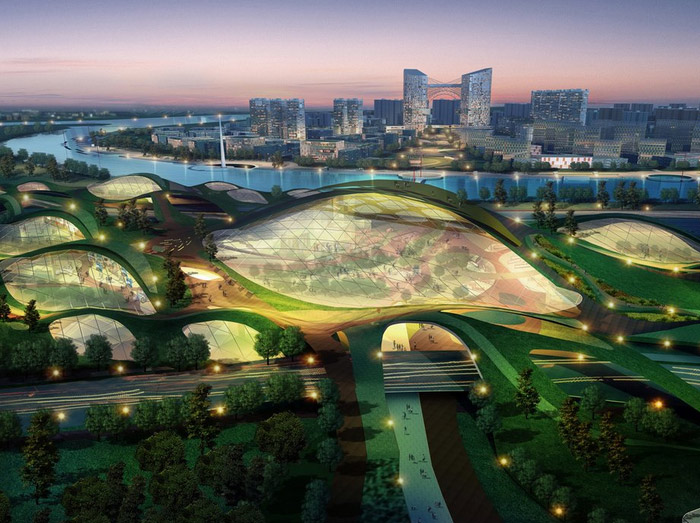Sino-Singapore Tianjin Eco-city
Sino-Singapore Tianjin Eco-city is a strategic cooperation project between China and Singapore to improve the living environment and build an eco-culture. It is another highlight project after Suzhou Industrial Park. Bearing realistic and historical significance, the project reflects two country’s strong determination in combating climate change, enhancing environment as well as saving resources and energy. Therefore, both Chinese and Singaporean leaders have attached great emphasis, and made important remarks on the project.
Sino-Singapore Tianjin Eco-city is located in an important national strategic area—Tianjin Binhai New Area. Right at the middle of Tanggu District and Hangu District, and adjacent to TEDA, Tianjin Port, Coastal Leisure Zone, the site is 45km to Tianjin Proper, 150km to Beijing. The city’s total area is 31.23 sq km with a planned population of 350,000. Stretching out to Central Avenue of TBNA to the east, Ji River to the west, Rainbow bridge to the south and Jinhan highway to north, Sino-Singapore Tianjin Eco-city enjoys a convenient transportation system and energy supply, making it an important living area of TBNA.
SITE SELECTION
Abiding by the principles of obtaining land through legal procedures, saving land and water, realizing resource recycling and enhancing independent innovation, the project is placed at an water-lacking area with salty land, scarce vegetation, unfavorable natural conditions and fragile ecology.
Meanwhile, backed by neighboring big cities, the site is connected to good transportation network and a low infrastructure cost is good for the ecological restoration.
KEY PERFORMANCE INDICATORS FRAMEWORK
Based on the current conditions of resources, environment and human settlement of the Eco-city site, the KPI framework has followed a human-oriented perspective and encompassed such four aspects as Healthy Ecological Environment, Social Harmony & Progress, Vibrant and Efficient Economy in 22 quantitative indicators and Integrated Regional Coordination in 4 qualitative indicators to guide the development of the Eco-city.
It will also provide technical support and construction approaches to ensure that the development mode replicable, practicable and scalable.
In accordance with the four selection principles, i.e.(i) scientific and practical;
(ii) qualitative and quantitative;
(iii) unique characteristics & similarities and
(iv) attainable and expandable, the KPI framework has retained the essence and heightened the standards of urban planning. It is a reflection of the new requirements in urban construction with emphasis on the preservation and restoration of the natural ecology, and will serve to construct a natural ecological system with sound ecological structure, enhanced service functions and superb environment quality, and a coordinated man-made environmental system.
PLANNING AND DESIGNING
Sino-Singapore Tianjin Eco-city has applied the planning concept of eco-economy, eco-residence, eco-culture, harmonious community and scientific management. By integrating advanced ecological, environmental protection, and energy-saving techniques, it will create a natural, harmonious and livable human residence, and thus commit itself to constructing an eco-city that is economically vibrant, environmentally friendly, resource-efficient and socially harmonious.
The project will promote the use of clean energy and renewable energy/resources, with strengthened innovation capabilities and optimized industrial structure to achieve a highly-efficient recycling economy.
An eco-culture with regional features will be formed to promote a green and healthy style of life and consumption. Focusing on coordination with the neighboring regions in terms of environment, socio-culture, economy and policy will help to realize regional integration.
天津中新生態城
雅言组 译
中新天津生态城 是中国、新加坡两国政府战略性合作项目,是继苏州工业园之后两国合作的新亮点。生态城市的建设显示了中新两国政府应对全球气候变化、加强环境保护、节约资源和能源的决心,为资源节约型、环境友好型社会的建设提供积极的探讨和典型示范。
地理环境
选址用地区位优势明显,距天津中心城区45公里,距北京150公里,距唐山50公里,距滨海新区核心区15公里,距天津滨海国际机场40公里,距天津港20公里,距曹妃甸工业区30公里,便于利用各种城市资源。选址用地东临正在建设的北疆电厂循环经济示范区,北接汉沽老城,西南为滨海新区核心区(包括天津经济技术开发区、天津港、天津港保税区和正在规划建设的滨海中心商务商业区)。选址具有良好的城市和产业依托,具备建设生态城的优越条件。
中新生态城的气候属于大陆性半湿润季风气候,四季特征分明。春季多风,干旱少雨;夏季炎热,雨水集中;秋季天高气爽;冬季寒冷,干燥少雪。年平均气温12.5℃,最高气温39.9℃,最低气温-18.3℃。年平均降雨量602.9毫米,降水多集中在7、8月份,占全年降水量的60%。年蒸发量为1750—1840毫米,是降水量的3倍左右。每年1~3月份西北风最多;4~6月份以南风居多;从7月份开始到9月份东风最多;10~12月份,西北风、西南风最多。年平均日照时数为2898.8小时,平均日照百分率为64.7%。
交通条件
选址周边有国家客运专线(高速铁路)、城际铁路(公交化高速铁路)、普铁和城市轨道交通(轻轨),构成连通中心城区、滨海新区、北京市及周边城市的快捷的轨道交通网络。
规划的京津唐城际铁路沿津汉快速路方向从该选址范围北侧通过,并在选址区东北部2公里处设有城际车站,方便与北京、天津中心城区、唐山的联系。其中北京南站至天津东站段已于2005年7月开工建设,计划2007年底完成,2008年8月1日投入运营。
规划的天津至秦皇岛的津秦客运专线(高速铁路),在汉沽设有车站,距生态城项目约4公里。计划今年开工,2010年建成。按照铁道部的意见,京津城际延长至滨海新区段,近期与津秦客运专线并线。因此在2010年前,京津城际铁路一定能通达滨海新区核心区。
中心城区地铁9号线(津滨轻轨),将延伸至生态城并设站,使生态城直达天津中心城区。
市政基础设施
基础设施条件较为完备,为中新生态城提供了水、气、电、热、通讯等基础设施保障。
目前该区域用水主要依靠地下水,在汉沽区有汉沽水厂。该地区供电电源来自汉沽220KV变电站、塘沽区孟港后220 KV变电站、营城110KV变电站、茶店110KV变电站。该地区通讯由汉沽区网通公司提供。现状汉北路上有一条Φ600高压天然气管道。位于规划区东北侧的北疆热电厂正在建设。按照规划,该地区的用水由汉沽水厂及规划的汉沽海水淡化水厂提供。污水可排入在建的营城污水处理厂,规模为50万吨/日。近期污水厂建成后处理量可达到10万吨/日,每日可生产5万吨的再生水。该地区供电纳入滨海新区供电系统,建立220KV高压送电网、110KV、35KV高压配电网、10KV中压配电网和380/220V低压配电网构成的供电结构体系。在选址范围内规划安排一座电话局,在建成前由汉沽区电话局提供服务。规划区气源为陕北天然气。由规划北疆热电厂为规划区提供热源。
特点
一、第一个国家间合作开发建设的生态城市。
二、选择在资源约束条件下建设生态城市。
三、以生态修复和保护为目标,建设自然环境与人工环境共熔共生的生态系统,实现人与自然的和谐共存。
四、以绿色交通为支撑的紧凑型城市布局。
五、以指标体系作为城市规划的依据,指导城市开发和建设的城市。
六、以生态谷(生态廊道)、生态细胞(生态社区)构成城市基本构架。
七、以城市直接饮用水为标志,在水质性缺水地区建立中水回用、雨水收集、水体修复为重点的生态循环水系统。
八、以可再生能源利用为标志,加强节能减排,发展循环经济,构建资源节约型、环境友好型社会。













